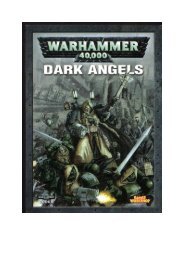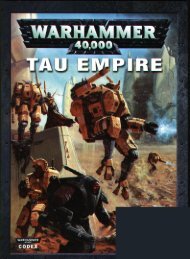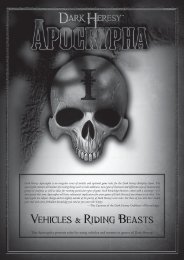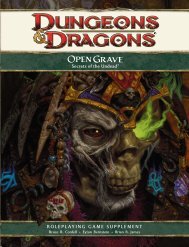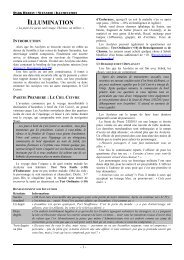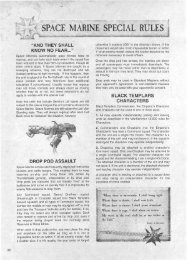4e_Monster_Manual_2 - Free
4e_Monster_Manual_2 - Free
4e_Monster_Manual_2 - Free
You also want an ePaper? Increase the reach of your titles
YUMPU automatically turns print PDFs into web optimized ePapers that Google loves.
LEVEL AND ROLEA monster's level and role are tools for the DM to usewhen building an encounter. Chapter 4 of theMaster's Guide explains how to use these tools.DungeonLevel: A monster's level summarizes how tough itis in an encounter. Level determines most of the monster'sstatistics as well as the experience point (XP)award the PCs earn for defeating it (DungeonGuide, pages 56-57).Role: A monster's role describes its preferredMaster'scombat tactics, much as a character class's role suggeststactics for PCs. <strong>Monster</strong> roles are artillery, brute,controller, lurker, skirmisher, and soldierMaster's Guide, pages 54-55).(DungeonA monster might have a second role: elite, solo,or minion. Elite monsters and solo monsters aretougher than standard monsters, and minions areweaker. For the purpose of encounter building, anelite monster counts as two standard monsters of itslevel, a solo monster counts as five, and four minionscount as one.In addition, a monster might have the leader subrole,indicating that it grants some sort of boon to itsallies, such as a beneficial aura.SIZEA creature's size determines its space as well as itsreach.<strong>Monster</strong> Size Space ReachTiny 1/2 x 1/2 0Small 1 x 1 1Medium 1 x 1 WSMLarge 2x2 1 or 2Huge 3x3 2 or 3Gargantuan 4 x 4 or larger 3 or 4Space: This is the area (measured in squares) thata creature occupies on the battle grid.Reach: If a creature's reach is greater than 1,the reach is noted in any melee power the creaturehas that uses that reach. Even if a creature's reach isgreater than 1, the creature can't make opportunityattacks against targets that aren't adjacent to it unlessit has threatening reach.A creature that has reach 0 cannot normally makemelee attacks outside its own space.ORIGINA monster's origin summarizes its place in the D&Dcosmology. Origins are aberrant, elemental, fey,immortal, natural, and shadow. See the glossary forinformation about each origin.TYPEA creature's type summarizes some basic thingsabout its appearance and behavior. Types are animate,beast, humanoid, and magical beast. See theglossary for information about each type.KEYWORDSSome monsters have keywords that further definethem. These keywords represent groups of monsters,such as angel, demon, devil, dragon, and undead. Seethe glossary for definitions of a monster's keywords.SENSESEvery monster has a Perception modifier. Some monstersalso have special senses, such as darkvision ortremorsense, which are noted in the "Senses" entry.AURAIf a monster has an aura, that is noted near the top ofits statistics block. An aura is a continuous effect thatemanates from the monster. See the glossary for moreabout auras.REGENERATIONSome monsters have regeneration. At the start of eachof its turns, a monster that has regeneration regains aspecific number of hit points, as long as the monsterhas at least 1 hit point.The regeneration of some monsters can be suppressedby certain types of damage or by specificcircumstances, and some creatures can use regenerationonly under specific circumstances (for example,only while bloodied).SPEEDIf a monster has alternative movement modes, suchas fly, climb, or swim, that fact is noted in its speedentry.ACTION POINTSElite and solo monsters have action points they canspend to take extra actions, just as PCs do. UnlikePCs, a monster can spend more than 1 action point inan encounter, but only 1 per round.POWERSA monster's powers are presented so that its basicattacks appear first, followed by its other powers.TYPEEach power has an icon that represents its type:melee (I), ranged (pf), close (




